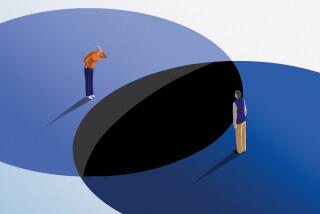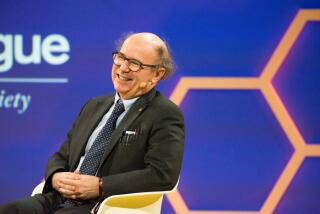Stephen Hawking, who redefined the view of the universe for scientists and public alike, dies at 76
Stephen Hawking, the British physicist whose body was chained to a wheelchair by the ravages of a degenerative neuromuscular disease, but whose mind soared to the boundaries of the universe and beyond, died Wednesday morning in Cambridge, England. He was 76.
His death came from complications of amyotrophic lateral sclerosis, more commonly known as Lou Gehrig’s disease, from which he had suffered since he was 20.
“He was a great scientist and an extraordinary man whose work and legacy will live on for many years,” his children, Lucy, Robert and Tim, said in a statement obtained by the Associated Press. “His courage and persistence with his brilliance and humor inspired people across the world…. We will miss him forever.”
Hawking, whose contributions to theoretical physics are frequently compared to those of Albert Einstein, was the Lucasian professor of mathematics at Cambridge University, occupying the same seat once held by Sir Isaac Newton. From that venerated position, he changed the way the universe is viewed by physicists and laymen alike — the former through his seminal theories about the nature of black holes and the origin of the universe, the latter with a bestselling book, “A Brief History of Time,” which fulfilled his ambition by appearing on the shelves of airport newsstands throughout the world.
Carrying out complex mathematical calculations in his head because of his physical inability to use pencils — a feat once compared to Mozart scoring an entire symphony in his head — and speaking only with a computer-controlled speech synthesizer, Hawking reshaped basic ideas about the universe not once but twice. He first helped to promote the theory that the universe originated in a “big bang” about 15 billion years ago, then reversed field and postulated a universe without beginning or end.
Hawking’s field was cosmology, the branch of physics that deals with the origin, structure and evolution of the universe. “My goal is simple,” Hawking once told Science magazine. “It is complete understanding of the universe, why it is as it is and why it exists at all.”
Hawking made his reputation with his study of “singularities,” unimaginable objects predicted by Einstein’s theory of general relativity. When a star with several times the mass of our sun exhausts its nuclear fuel, it collapses, its matter crushing together with such force that it forms a singularity, an infinitely dense point with no dimensions and infinitely large gravity.
The region around the singularity is a black hole, whose immense gravity prevents anything, including light, from escaping.
Although a variety of evidence confirmed the existence of black holes, physicists in the 1960s were less sure about singularities, questioning whether a real object could be so small as to be dimensionless and nonetheless be infinitely dense.
As a Cambridge graduate student working with mathematician Roger Penrose of Birkbeck College in London, Hawking was able to prove mathematically that, if Einstein’s general relativity is correct, then singularities must exist precisely as described. He subsequently showed, also if general relativity is correct, that the universe must have begun as a singularity, which exploded in the tremendous burst of the big bang.
Later, he also demonstrated that the big bang must have created huge numbers of mini-black holes, each with the mass of a mountain condensed into a space the size of a proton. He reached the then-startling conclusion that these mini-black holes would evaporate, shedding particles in spite of their massive gravity.
According to his theory, “empty space” at the edge of a mini-black hole would occasionally release two complementary particles — matter particles and antimatter particles (which effectively add up to “nothing”). Hawking reasoned that if the particle pair were created at the edge of a black hole, one of them would fall into the hole while the other would fly off into space. Therefore, the hole would radiate away some of its energy.
Because energy and mass are equivalent, the mass of the black hole would shrink. Stellar-size or larger black holes take in enough matter to compensate for whatever they might lose from this process, but a microscopic black hole would evaporate entirely.
When he first presented his revolutionary idea at a 1974 symposium at Rutherford Laboratory near Oxford, the conference moderator shut off debate on his proposal, saying, “Sorry, Stephen, but this is absolute rubbish!” Today, these particles are widely accepted and are known as “Hawking radiation.”
Hawking also concluded that, 10 billion years or more after their formation, these black holes would ultimately explode with the energy of millions of hydrogen bombs. Such an explosion has not yet been observed, but if it were, Hawking once noted, “I would get the Nobel Prize.”
In later years, Hawking and UC Santa Barbara physicist James Hartle reached the remarkable, not to mention ironic, conclusion that the universe is a self-contained object that, like the Earth’s surface, has no edge or boundary, no beginning or end. If that is the case, Einstein’s theory of general relativity would have to be modified, Hawking argued, and there would be no singularities.
“The universe would not be created, not be destroyed; it would simply be,” he concluded. “What place, then, for a creator?”
George Smoot, professor of physics at UC Berkeley and a longtime friend and colleague of Hawking, said his contributions were original and far-reaching, reframing ideas about the origins of the universe and the nature of time and space.
Stephen William Hawking was born in Oxford on Jan. 8, 1942, exactly 300 years after the death of the great astronomer Galileo, as he often noted. He was raised in London and St. Albans in Hertfordshire.
He was an unexceptional student, slow to read, and never placing above the middle of his class in elementary or high school. But “it was a very bright class,” he often quipped.
Hawking frequently recited a story from his childhood: “When I was 12, one of my friends bet another friend a bag of sweets that I would never come to anything. I don’t know if the bet was ever settled, and, if so, which way it was decided.”
Entering Oxford, he wanted to major in mathematics, but his father, a researcher on tropical diseases, disparaged the job prospects of a mathematician and encouraged him to study biology. As a compromise, he studied physics.
By his own admission, Hawking had “an attitude of complete boredom and a feeling that nothing was worth making an effort for.” He was the prototypical gentleman student, partying frequently, serving as coxswain of the second-string crew and studying for only about an hour a day. Nonetheless, he graduated with “first class honors” — the highest — when he gave an impressive performance on an oral exam at the conclusion of his studies.
He entered graduate school at Cambridge but had difficulty in mastering the physics courses, in no small part because his movements were clumsy and awkward. Physicians diagnosed his condition as amyotrophic lateral sclerosis in his first year and predicted that he would live only three to five years, an outlook that plunged him into depression. He neglected his studies and spent much of his time drinking, listening to Wagner records and reading science fiction.
But remarkably, the progression of his disease slowed. He also began to make progress in understanding general relativity and, perhaps more important, met and became engaged to Jane Wilde, an undergraduate studying modern languages at Westfield College in London.
“If we were to get married,” he later said, “I had to get a job. And to get a job, I had to finish my PhD. I therefore started working hard for the first time in my life. To my surprise, I found that I liked it.”
The couple married in 1965 and had three children, Robert, Lucy and Tim. The couple separated in 1990 and later divorced. In 1995 Hawking married his onetime nurse, Elaine Mason; they divorced in 2006.
By the early 1970s, Hawking had begun to make a name for himself in the insular world of physics, but his disease had progressed to the point where he was confined to a wheelchair. The family found accommodations in a ground-floor apartment owned by the university, only half a mile from his office. He made the daily commute in his electric wheelchair.
In 1977, when he was 35, Cambridge conferred a rare honor on Hawking by creating a special chair for him, professor of gravitational physics. The majority of British academicians never become full professors, much less at such an early age. Two years later, he became Lucasian professor.
As his speech deteriorated, Hawking’s words were interpreted by one of the three nurses who were with him around the clock, by one of his graduate students who usually accompanied him on his wide travels, or by his wife. But in 1985, while visiting Geneva, he nearly suffocated when he contracted pneumonia.
Physicians performed a tracheotomy, permanently installing a tube in his throat through which he could breathe comfortably. But in saving his life, they muffled his voice forever. Afterward, he was only able to “speak” through a speech synthesizer, which he controlled by operating his onboard computer through slight motions of his hand.
Characteristically, his only complaint about having to use the device was that it gave him an American accent: It was built in California.
He found great mobility in his electric wheelchair, taking it onto the dance floor of a New York City discotheque. In 1978, demonstrating his prowess in the chair to Prince Charles by spinning it around and around, he ran over the prince’s toes.
In 1988, Hawking published his critically acclaimed book, “A Brief History of Time.” The book was a popular success as well, dominating the bestseller charts and translated into more than 22 languages. “I knew it was going to be a success when I sold the rights in Serbo-Croatian,” he said.
He also made appearances on PBS’ “Nova,” was on the cover of Newsweek and profiled in Time, and was the subject of several TV programs focusing on both his scientific prowess and his courageous life.
“Stephen Hawking was to science what Magic Johnson was to basketball,” Smoot said. “The brains, the presence, the initiative and also the physicality” — not Johnson’s poetry in motion, but something of equal intensity.
In recent years, Hawking’s disability had worsened to the point where he could move only some facial muscles and fingers. Yet he remained an energetic — even flamboyant — partygoer, counting movie stars as his friends. He made cameo appearances in “Star Trek: The Next Generation” and as an animated character in TV’s “The Simpsons.” That episode depicted Hawking saving the town from misguided members of the local Mensa genius society.
In a statement prepared for the Muscular Dystrophy Assn.’s newsmagazine in 1989, he reflected on his disability:
“I suppose that I would be described as a severely disabled person, but that is not how I see myself. Rather, I see myself as a scientist who happens to be disabled, just as I might happen to be colorblind. Most people are disabled or disadvantaged in some way. I may be a bit more disabled than many, but it is just in physical ways that can be helped by other people and by equipment like my wheelchair and computer. I have been very lucky that my disability has not prevented me from doing what I really wanted to do, which is physics.”
Leading scientists respected Hawking’s many contributions, but some viewed his personal heroism and charisma as having prompted admirers to exaggerate their significance by comparing him to Newton or Einstein.
Smoot said that it might be decades before such comparisons can be validated by experiments or observation.
“Nothing that Hawking has done has ever really been tested empirically,” he said. “We think that they are right — the logic is impeccable and the math is great — but we haven’t been able to get close enough to a black hole ... or go back to the beginning of the universe.”
Hawking never dwelled on the “what ifs” — never questioning what he might have accomplished had he not been disabled:
“I doubt that it would have been much different. I have done most of the things that I wanted to do. Anyway, there is no good thinking about what might have been. I might as well wonder what I might have done if I had not been good at physics.”
After his reputation was established, Hawking succumbed to the siren call that seduces many theoretical physicists: the search for the grand unified theory, or “theory of everything,” that ties all the forces of nature into one neat bundle.
His early life was chronicled in the 2014 film by the same name, with Eddie Redmayne winning the best actor Academy Award for his portrayal of the scientist.
Though he was not successful in this final quest to prove his theory, Hawking was convinced that when it was ultimately discovered, its inevitable simplicity would make it as intelligible to laymen as to physicists. As he concluded in his book:
“Then we shall all, philosophers, scientists, and just ordinary people, be able to take part in the discussion of the question of why it is that we and the universe exist. If we find the answer to that, it would be the ultimate triumph of human reason — for then we would know the mind of God.”
Former Times staff writer Charles Piller and the Associated Press contributed to this report.
UPDATES:
11:00 p.m.: This article has been updated for additional details and for clarity.
This article was originally published at 9:45 p.m.
More to Read
Start your day right
Sign up for Essential California for the L.A. Times biggest news, features and recommendations in your inbox six days a week.
You may occasionally receive promotional content from the Los Angeles Times.






